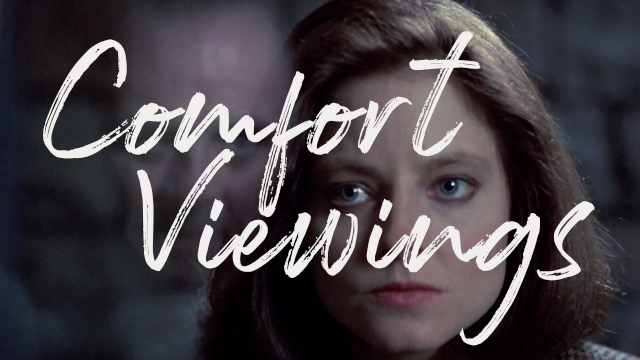Comfort Viewings #7: Scared at first and then exhilarated
By Becky Darke
Note: This article contains spoilers for The Silence of the Lambs (and bad language)
I can’t say exactly when The Silence of the Lambs (1991) changed from a film I’d watch to revisit the scares and exhilaration of my first viewing, to one I put on when I want to unwind.
I was ten or eleven when I first saw Jonathan Demme’s horror masterpiece. I think I watched the UK television premiere; I was definitely at the house I shared with both my parents before they split, and when the incredible French and Saunders skit aired in ‘93, I got what it was spoofing.
It would certainly explain why my parents let me watch the film. Maybe they thought it was just an Oscar winner with Anthony Hopkins. And it was probably listed as a thriller. *hard eye roll*
What I do know, is that first watch coloured every viewing since and laid the groundwork for The Silence of the Lambs becoming my ultimate comfort movie.
In the films we come back to time and again, we develop relationships with images, sounds, musical motifs, favourite scenes, character moments and much-quoted lines. These cinematic touchpoints are the landmarks that let us know we’re nearly home.
You can trust what you’re watching. You’ve been here before.
As evidenced by my youthful introduction to Clarice Starling (Jodie Foster), Hannibal Lecter (Anthony Hopkins) and the gang, my love of horror goes way back, to when I found myself not traumatised by scary movies but thrilled by them. It’s that feeling that has me returning to the genre over and over and, of course, to specific films. It’s a heady mix: the familiarity that means you know you’re safe, and the catharsis that comes from a well-crafted scare.
“Oh wait, was she a great big fat person?”
The final stand-off, when Buffalo Bill (Ted Levine) pursues Clarice through absolute darkness, is my first memory of being truly terrified during a movie.
That whole last act: how your stomach drops with Clarice’s as you watch her realise he’s the guy; her discovery of Catherine (Brooke Smith) and “Don’t you leave me here you fucking bitch!”; the decomposing body in the bathtub and then, just as the shot gives you time to really understand the wrongness of it, the lights go out. But we can see with Bill, through the electronic green of his night-vision goggles. We see Clarice stumble and blindly wave her pistol. We hear her fast, heavy breathing. He’s right there, reaching out to touch her hair, her face. And then he raises his gun, twice the size of hers, but he must cock it. Her training kicks in and BLAM.
White-knuckle terrifying, yes. But it was also the moment I first felt that jolt of intoxicating relief as you realise your hero - and you - have survived. So, these moments, these beats, these landmarks, keep bringing us back to the last time we watched the film, and the time before that, and back to the first time.
“I can smell your cunt.”
Miggs’ (Stuart Rudin) vulgar cat-call didn’t mean much to me as a kid. But it’s more than a throw-away line for the sake of dropping the c-bomb. We witness Clarice’s boldness in repeating it to Lecter, and I was fascinated by his recognition of L’air du Temps, a name I knew because it was a perfume my mum wore. It gave me a thrill to have a distant yet personal connection to this dark moment in this dark film.
“It matters Mr Crawford. Cops look at you to see how to act.”
The whole funeral home scene instantly seared itself onto my consciousness, but again, Clarice’s fearlessness stands out. For a moment, the camera is Clarice and pans over the faces of the small-town cops as they stare her down. I found her defiance electric; she sets her mouth firm and later wrangles them out of the room, “Go on, now”.
Having been presented by her boss as the delicate little woman while absolutely smashing it at her job, she calls Crawford (Scott Glenn) out for his performative sexism. I remember being impressed that not only does she tell him off, he takes the note!
“Make it last all night!”
We weren’t a Tom Petty household, so The Silence of the Lambs was the only place I heard American Girl for years. Catherine is so carefree in that moment. When we see her later, she’s filthy and screaming, bent on survival.
Incidentally, American Girl is now on heavy-rotation and a banger on my Halloween playlist, but the Most Valuable Player on the soundtrack is of course Goodbye Horses by Q Lazzarus.
“You ever go out for cheeseburgers and beer?”
The chemistry between Jodie Foster and Anthony Hopkins is undeniable; you could watch the film with your eyes shut and feel their weird energy humming off the screen. But it’s the ancillary characters that really create that nostalgia akin to coming home. It’s like bumping into someone on the local high street that you haven’t seen for ages.
Ardelia (Kasi Lemmons) is a textbook example of the ‘Black best friend’ (see Rachel True on this subject in Horror Noire: A History of Black Horror (2019), immediately) but she’s also a legit FBI badass, working shit out and having an impact on the world. And she has one of the best on-screen runs I’ve ever seen. The doctors (Dan Butler and Paul Lazar) with their bug chess, and the iconic cocoon scene: the cut, the goo, the skull. Barny (Frankie Faison), with his calming authority and kindness to Clarice, makes a lasting impression. And Precious (the fluffy evil mastermind behind it all?) brings bonus nostalgia points, played by the hard-working pooch Darla, who I was also loving in Joe Dante’s The ‘Burbs (1989) and Eerie, Indiana (1991-92). When I see Catherine with Precious at the end of the film, clutching her like she’ll never let her go, I know those girls are going to be ok.
“I’m having an old friend for dinner.”
I don’t remember being surprised that Lecter gets away and immediately goes after Dr. Chilton (Anthony Heald, and for whom I felt an instant hatred and some primal instinct that he’s the true villain of the piece).
I knew Lecter would be free to kill again, that they couldn’t hold him for long. His intellect and viciousness are all too clear.
It has become a dizzy dance. I watch Lecter stroll after Chilton on his hungry murder mission, his pale suit and hat disappearing into the distance and, whenever I start the film again, Lecter is back in his cell. Of course, that’s one of the ultimate comforts: that some things will always remain constant, unchanged, while the world spins on in chaos.
Becky Darke is a London-based podcaster and film reviewer. She produces and co-hosts the ‘90s pop-culture podcasts Don’t Point That Horror At Me and Return to Eerie, Indiana. She’s also a regular contributor to The Evolution of Horror and The Final Girls. You can find Becky’s written reviews on the FilmBusters and Zobo With A Shotgun websites.
We've been going independently for years now, and so far have self-financed every single project. In order to do more work, and continue supporting amazing filmmakers in the genre space, we've launched a Patreon.
If you are able to support us and the work we do on Patreon, we'd truly and deeply appreciate it.


